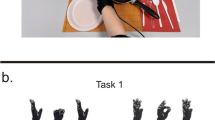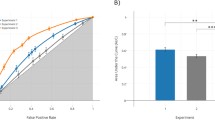Abstract
In the present study, we addressed the issue of whether healthy individuals can recognize a given gesture as their own, based on kinematic information. To this purpose, we required 36 volunteers to execute a series of hand movements of increasing complexity, while their kinematics was recorded by a motion-capture system. In a later session, we showed them a series of computer animations where a virtual hand, rendered as a simple stick-diagram, was animated by the kinematics recorded from the participants in the previous session. Their task was to recognize their own movements, choosing from three alternatives. To test the contribution of various potential cues to action recognition, the roles of (1) access to motor representation, (2) gesture complexity, and (3) familiarity effects were separately investigated. The results support the hypothesis that kinematic templates rather than single motor parameters contribute to self-recognition in the absence of morphological cues.





Similar content being viewed by others
References
Beardsworth T, Buckner T (1981) The ability to recognize oneself from a video recording of one’s movements without seeing one’s body. Bull Psychon Soc 18:19–22
Blakemore S-J, Decety J (2001) From the perception of action to the understanding of intention. Nat Rev Neurosci 2:561–567
Bruce V, Young A (1986) Understanding face recognition. Br J Psychol 77:305–327
Buccino G, Binkofski F, Riggio L (2004) The mirror neuron system and action recognition. Brain Lang 89:370–376
Corlett J T, Anton J, Kozub S, Tardiff M (1989) Is locomotor distance estimation guided by visual imagery? Percept Mot Skills 69:1267–1272
Daprati E, Sirigu A (2005) Action recognition disorders following parietal damage. In: Freund H-J, Jeannerod M, Hallet M, Leiguarda R (eds) Higher-order Motor Disorders - From neuroanatomy and neurobiology to clinical neurology. Oxford University Press, Oxford
Daprati E, Franck N, Georgieff N, Proust J, Pacherie E, Dalery J, Jeannerod M (1997) Looking for the agent: an investigation into consciousness of action and self-consciousness in schizophrenic patients. Cognition 65:71–86
Decety J, Jeannerod M, Prablanc C (1989) The timing of mentally represented actions. Behav Brain Res 34:35–42
Decety J, Perani D, Jeannerod M, Bettinardi V, Tadary B, Woods R, Mazziotta JC, Fazio F (1994) Mapping motor representations with positron emission tomography. Nature 371:600–602
Flach R, Knoblich G, Prinz W (2004) Recognizing one’s own clapping: The role of temporal cues. Psychol Res 69:147–156
Franck N, Farrer C, Georgieff N, Marie-Cardine M, Dalery J, d’Amato T, Jeannerod M (2001) Defective recognition of one’s own actions in patients with schizophrenia. Am J Psychiatry 158:454–459
Gerardin E, Sirigu A, Lehericy S, Poline JB, Gaymard B, Marsault C, Agid Y, Le Bihan D (2000) Partially overlapping neural networks for real and imagined hand movements. Cereb Cortex 10:1093–1104
Grafton ST, Arbib MA, Fadiga L, Rizzolatti G (1996) Localization of grasp representations in humans by positron emission tomography 2: observation compared with imagination. Exp Brain Res 112:103–111
Hall C, Pongrac J (1983) Movement imagery questionnaire. University of Western Ontario, London Ontario
Jeannerod M (1988) The neural and behavioural organization of goal-directed movements. Oxford University Press, Oxford
Jeannerod M (2001) Neural simulation of action: a unifying mechanism for motor cognition. Neuroimage 14:S103–S109
Jeannerod M, Frak V (1999) Mental imaging of motor activities in humans. Curr Opin Neurobiol 9:735–739
Johansson G (1973) Visual perception of biological motion and a model for its analysis. Percept Psychophys 14:201–211
Knoblich G, Flach R (2003) Action identity: evidence from self-recognition prediction and coordination. Conscious Cogn 12:620–632
Knoblich G, Prinz W (2001) Recognition of self-generated actions from kinematic displays of drawing. J Exp Psychol Hum Percept Perform 27:456–465
Kozlowski LT, Cutting JE (1977) Recognizing the sex of a walker from point-lights display. Percept Psychophys 21:575–580
Lacquaniti F (1989) Central representations of human limb movement as revealed by studies of drawing and handwriting. Trends Neurosci 12:287–291
Loula F, Prasad S, Harber K, Shiffrar M (2005) Recognizing people from their movement. J Exp Psychol Hum Percept Perform 31:210–220
Mahoney MJ, Avener M (1987) Psychology of the elite athlete: an explorative study. Cognit Ther Res 1:135–141
Nielsen TI (1963) Volition: a new experimental approach. Scand J Psychol 4:225–230
Oldfield RC (1971) The assessment and analysis of handedness: the Edinburgh inventory. Neuropsychologia 9:97–113
Repp BH, Knoblich G (2004) Perceiving action identity: how pianists recognize their own performances. Psychol Sci 15:604–609
Rizzolatti G, Fogassi L, Gallese V (2002) Motor and cognitive functions of the ventral premotor cortex. Curr Opin Neurobiol 12:149–154
Roth M, Decety J, Raybaudi M, Massarelli R, Delon-Martin C, Segebarth C, Morand S, Gemignani A, Decorps M, Jeannerod M (1996) Possible involvement of primary motor cortex in mentally simulated movement: a functional magnetic resonance imaging study. Neuroreport 7:1280–1284
Sirigu A, Cohen L, Duhamel JR, Pillon B, Dubois B, Agid Y (1995) A selective impairment of hand posture for object utilization in apraxia. Cortex 31:41–56
Sirigu A, Daprati E, Pradat-Diehl P, Frank N, Jeannerod M (1999) Perception of self-generated movement following left parietal lesion. Brain 122:1867–1874
Stephan KM, Fink GR, Passingham RE, Silbersweig D, Ceballos-Baumann AO, Frith CD, Frackowiak RS, van den Bos E, Jeannerod M (2002) Sense of body and sense of action both contribute to self-recognition. Cognition 85:177–187
Tsakiris M, Haggard P, Franck N, Mainy N, Sirigu A (2005) A specific role for efferent information in self-recognition. Cognition 96:215–231
Wolff W (1943) The expression of personality. Harper, New York
Acknowledgments
The authors are grateful to Dr. M. Carrozzo for support in setting up the motion capturing procedure, L. Granjon and V. Spurio for their help in preparing the virtual hand and presentation software, and Prof. G. Rizzolatti for discussing the data. The authors wish to thank B. Repp and an anonymous referee for editing and commenting on an earlier draft of the manuscript. The financial support of Italian University Ministry (PRIN and FIRB projects), Italian Health Ministry and Italian Space Agency is gratefully acknowledged.
Author information
Authors and Affiliations
Corresponding author
Appendix 1
Appendix 1
Analyses of kinematic parameters and selection of distractor-participants
Spatial and temporal parameters were analyzed as follows. The time course of the displacement of the markers placed on the fingertips was used to compute the beginning and end of each movement. The single data points were plotted and the waveform of each movement was analyzed by detecting all peaks of the function. Movement start was defined as the sample corresponding to the origin of the rising slope of the first peak, where the difference between two successive points significantly exceeded a constant noise factor (0.001) for the relevant marker (I4 for IT, IF and TL; the earliest finger-tip marker to show a stable displacement for HT and FT). Likewise, the temporal sample corresponding to the end of the falling slope of the last above-noise peak defined the end of the movement. Amplitudes (and angles) were defined on the basis of markers’ displacement compared to the plane of the table for the detected peaks. For all gestures, total movement time (time difference between the start and end of the movement) was computed. For IF, maximal angle of finger flexion was also analyzed. For the three tapping gestures, inter-tap intervals and maximal amplitude of hand/finger lift were computed. For TL, length of the line, peak velocity of the displacement of the marker on the index fingertip and elevation of the little finger on the plane of the table were measured. Means and variability across subjects for the analyzed parameters for the five gestures are reported in Table 1.
Based on this information, distractors for each participant were selected according to four constraints. First, main hand/finger dimensions differed by less than 0.5 cm. Second, for each gesture and for at least a half of the analyzed parameters, mean values recorded from the distractors’ movements were within a tolerance interval equal to the range defined by the observer’s movements. Third, mean values recorded from the distractors’ movements never exceeded this range by more than 25% for the remaining parameters. Finally, this was true for at least four out of five gestures.
Rights and permissions
About this article
Cite this article
Daprati, E., Wriessnegger, S. & Lacquaniti, F. Kinematic cues and recognition of self-generated actions. Exp Brain Res 177, 31–44 (2007). https://doi.org/10.1007/s00221-006-0646-9
Received:
Accepted:
Published:
Issue Date:
DOI: https://doi.org/10.1007/s00221-006-0646-9




